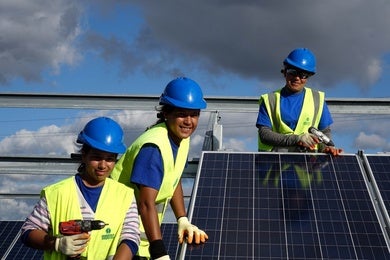IDB World: Financial Innovation; Private Funding for the Power Sector; Green Housing

Can financial innovation reduce the housing deficit?
There are few things that improve people’s quality of life more than having access to decent housing. However, the deficit of this type of housing in Latin America and the Caribbean (LAC) is currently more than 45% and it is estimated that it could reach 90% in 2050 if nothing is done to fix it.
Closing the current housing gap in the region will require an investment of at least US$310 billion, or 7.8% of its gross domestic product (GDP). To meet future demand for housing, investments of at least US$70 billion a year are needed. In this context, the role of financial institutions is especially relevant when it comes to meeting the needs of both the demand and the supply of affordable housing, with low carbon emissions, resilient to climate change and with a gender approach.
The solution to the housing deficit is being coordinated from many angles, both in the public and private sectors, but one of the most promising, and least known, is that of financial innovation. In recent years there have been great advances in access to financing for housing purchases with new approaches to gender and environmental sustainability.
How open to private-sector involvement is the electric power industry in Latin America and the Caribbean?
The IDB has estimated that in less than 10 years (by 2030), Latin America and the Caribbean needs more than $577 billion to close the electric power gap. Of that total, the region will need around $397 billion to build new generation, transmission, and distribution infrastructure, and more than $180 billion to replace and maintain existing assets. Private investment, which accounted for 75% of total investment in the region’s energy sector from 2016 to 2020, will continue to be a critical source of capital. The private sector can also contribute much-needed innovation to modernize electrical power systems and, in some cases, make them more efficient.
The ownership, assets, and operation of the electricity sector varies widely across Latin America and the Caribbean. Some countries are more open to private sector participation, while others prefer tighter government control.
Why should the private sector get involved in the development of green housing?
Before COVID-19 came into our lives, no one could have imagined that for many of us, the world would be largely reduced to the four walls of our home for almost two years. Lockdown underscored just how important our homes are for our quality of life and the urgent need to guarantee access to housing for all, especially in Latin America and the Caribbean (LAC), where there is an acute shortage of adequate, affordable housing.
In this blog post, which is part of a series about the IDB Group´s 2022 Housing Forum, we address the important role of the private sector, and especially that of housing developers, in closing the housing gap of our region through a greater focus on green housing. If you are interested in this topic, do not hesitate to register here and join the conversation of the panel of experts entitled “Solutions to the housing deficit through sustainable housing of social interest” on September 30.
In LAC there is a quantitative housing deficit (absence of housing) estimated at more than 23 million homes, and a qualitative deficit (houses in poor condition) of more than 43 million homes. Therefore, reducing the housing deficit is not just a matter of building houses, but of ensuring that they are of high quality, have access to basic services and are in accordance with urban planning policies. Another very important aspect is the need to have green homes. Buildings in LAC are estimated to consume 21% of treated water and 42% of electricity and generate 25% of CO2 emissions. A transition to green buildings could help reduce energy consumption by 50%, water consumption by 40% and CO2 emissions by 39%.
LIKE WHAT YOU JUST READ?
Subscribe to our mailing list to stay informed on the latest IDB Invest news, blog posts, upcoming events, and to learn more about specific areas of interest.
Subscribe


